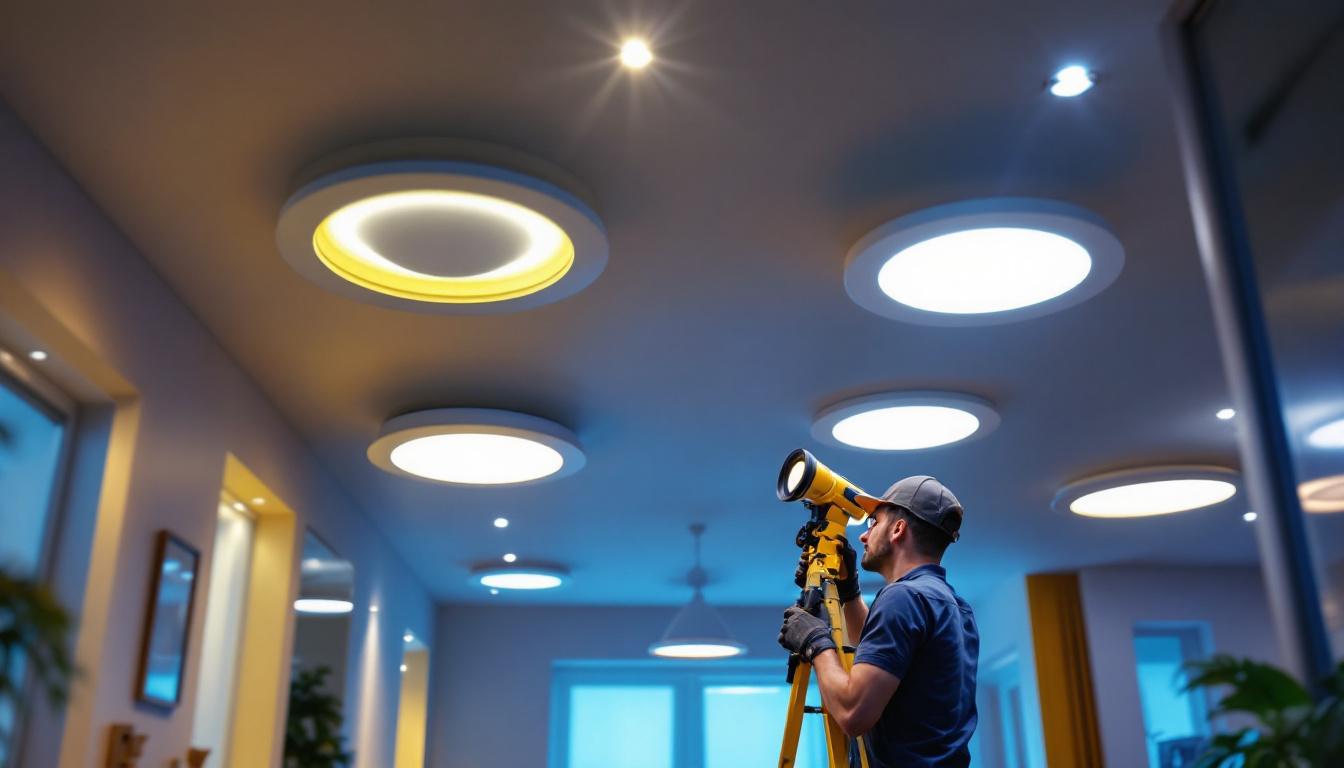
Lighting plays a crucial role in creating the desired ambiance in residential and commercial spaces. As the demand for energy-efficient solutions continues to grow, dimmable LED lights have become increasingly popular. However, to maximize their potential, lighting contractors must understand the essential facts about dimmer switches designed specifically for these types of bulbs. This article aims to provide valuable insights into the compatibility, installation, and benefits of using dimmer switches for dimmable LEDs.
Dimmable LED lights are designed to adjust brightness levels, allowing users to create the perfect atmosphere for any setting. Unlike traditional incandescent bulbs, which dim by reducing voltage, LEDs require specialized dimmer switches to function correctly. This is due to the unique way LEDs operate, relying on electronic circuits rather than filaments. The ability to dim LED lights not only enhances the aesthetic appeal of a space but also contributes to energy savings, as lower brightness levels consume less power.
When selecting dimmable LEDs, it is essential to ensure compatibility with the dimmer switch being used. Not all dimmers are created equal, and using the wrong type can lead to flickering, buzzing, or even damage to the bulb. Therefore, understanding the technology behind dimmable LEDs is the first step for lighting contractors looking to provide optimal solutions for their clients. Additionally, the market has seen a surge in smart dimmable LED options, which can be controlled via mobile apps or voice commands, adding a layer of convenience and customization for users.
Dimmable LEDs come in various forms, including standard bulbs, floodlights, and decorative fixtures. Each type may have different specifications and compatibility requirements. For instance, some LED bulbs are designed to work with trailing-edge dimmers, while others may be compatible with leading-edge dimmers. Understanding these distinctions is vital for lighting contractors to ensure seamless integration into existing lighting systems. Furthermore, the design of the fixture itself can influence the performance of the dimmable LED; for example, recessed lighting may require specific types of bulbs to achieve the desired dimming effect without compromising on light quality.
LEDs require drivers to convert the electrical current into a usable form. The driver plays a significant role in how the dimming function operates. Some drivers are specifically designed for dimming, while others are not. When selecting a dimmable LED, it is crucial to check the specifications of the driver to ensure it can handle the dimming function effectively. A mismatch can lead to poor performance and a negative experience for the end-user. In addition, the quality of the driver can affect the longevity of the LED bulb; high-quality drivers can help prevent overheating and extend the lifespan of the lights, making them a more cost-effective choice in the long run. As the technology continues to evolve, manufacturers are also focusing on developing drivers that minimize energy loss and maximize efficiency, further enhancing the appeal of dimmable LED solutions.
Selecting the appropriate dimmer switch is crucial for achieving optimal performance with dimmable LEDs. Not all dimmer switches are compatible with LED technology, and using an incompatible dimmer can lead to various issues, including flickering and reduced lifespan of the bulbs.
There are several types of dimmer switches available, each designed for specific applications. Understanding these options allows lighting contractors to make informed decisions when recommending products to clients.
Leading-edge dimmers are the traditional type of dimmer switches that work by cutting off the beginning portion of the AC waveform. While they are suitable for incandescent and halogen bulbs, they may not perform well with dimmable LEDs. Trailing-edge dimmers, on the other hand, are designed specifically for electronic loads and are generally more compatible with LED technology. They provide smoother dimming and reduce the risk of flickering.
When choosing between leading-edge and trailing-edge dimmers, it’s important to consider the specific lighting needs of the space. For example, leading-edge dimmers can sometimes be more cost-effective and may still be a viable option for homes that primarily use incandescent lighting. However, for modern installations featuring a mix of LED and other lighting types, trailing-edge dimmers are often recommended due to their superior performance and energy efficiency. Additionally, trailing-edge dimmers tend to generate less heat, which can contribute to a longer lifespan for both the dimmer and the connected bulbs.
With the rise of smart home technology, smart dimmers have become increasingly popular. These dimmers can be controlled via smartphone apps or voice commands, providing added convenience for users. Lighting contractors should consider recommending smart dimmers to clients looking to enhance their home automation systems. However, it is essential to ensure that the smart dimmer is compatible with the specific LED bulbs being used.
Moreover, smart dimmers often come with additional features that can enhance the user experience, such as customizable lighting scenes and scheduling options. For instance, homeowners can set their lights to gradually brighten in the morning, simulating a natural sunrise, or dim them in the evening to create a cozy atmosphere for relaxation. Some smart dimmers also integrate with other smart home devices, allowing for coordinated control of lighting with security systems, thermostats, and more. This level of integration not only adds convenience but can also contribute to energy savings, as users can easily monitor and adjust their lighting usage based on their daily routines.
Proper installation of dimmer switches is critical for ensuring optimal performance and safety. Lighting contractors should adhere to best practices during installation to avoid common pitfalls that can lead to issues down the line.
Before installation, it is essential to turn off the power at the circuit breaker to prevent electrical shock. Additionally, contractors should verify that the existing wiring is suitable for the new dimmer switch. In some cases, upgrading the wiring may be necessary to accommodate the new technology.
Understanding the wiring configurations is vital for a successful installation. Most dimmer switches will have a straightforward wiring setup, typically involving a line wire, load wire, and ground wire. However, in multi-way setups, where multiple switches control the same light fixture, the wiring can become more complex. Lighting contractors should familiarize themselves with the specific wiring diagrams for the dimmer switch being installed to ensure proper functionality.
After installation, testing the dimmer switch and the connected LED bulbs is crucial. Lighting contractors should check for any flickering, buzzing, or inconsistencies in brightness. If issues arise, troubleshooting may involve adjusting the settings on the dimmer switch or ensuring that the LED bulbs are compatible with the dimmer. Providing clients with guidance on how to troubleshoot common issues can enhance customer satisfaction and reduce callbacks.
The combination of dimmable LEDs and compatible dimmer switches offers numerous benefits for both contractors and end-users. Understanding these advantages can help contractors effectively communicate the value of these solutions to their clients.
Dimmable LEDs are inherently more energy-efficient than traditional incandescent bulbs. When paired with a dimmer switch, users can further reduce energy consumption by lowering the brightness when full illumination is not necessary. This not only leads to lower electricity bills but also contributes to a more sustainable environment.
Adjustable lighting allows users to create the perfect ambiance for any occasion. Whether it’s a cozy dinner party or a bright workspace, dimmable LEDs provide flexibility that fixed lighting cannot offer. Lighting contractors can emphasize this benefit when discussing options with clients, highlighting how dimmable solutions can enhance the overall experience in a space.
Despite the growing popularity of dimmable LEDs, several misconceptions persist regarding their use and compatibility with dimmer switches. Addressing these misconceptions can help lighting contractors better educate their clients and promote informed decision-making.
One of the most common misconceptions is that any dimmer switch will work with dimmable LEDs. As previously mentioned, this is not the case. Using an incompatible dimmer can lead to performance issues, including flickering and reduced lifespan of the bulbs. Lighting contractors should clarify this point to clients and recommend appropriate dimmer options.
Another misconception is that dimming LED lights will shorten their lifespan. In reality, when used with compatible dimmer switches, dimmable LEDs can maintain their longevity. In fact, reducing the brightness can actually extend the lifespan of the bulb, as lower power levels generate less heat, which is a significant factor in LED degradation.
The landscape of lighting technology is continually evolving, and dimmable LEDs are no exception. Staying informed about emerging trends can help lighting contractors remain competitive and provide cutting-edge solutions to their clients.
As smart home technology continues to advance, the integration of dimmable LEDs with smart systems is expected to become more seamless. Future dimmer switches may incorporate more advanced features, such as adaptive dimming based on natural light levels or user preferences. Lighting contractors should keep an eye on these developments to offer clients the latest innovations.
With a growing emphasis on sustainability, the demand for energy-efficient lighting solutions will likely continue to rise. Dimmable LEDs align perfectly with this trend, offering both energy savings and reduced environmental impact. Lighting contractors can position themselves as leaders in sustainable lighting solutions by promoting the benefits of dimmable LEDs and their compatibility with modern dimmer technology.
Understanding the essential facts about dimmer switches for dimmable LEDs is crucial for lighting contractors looking to provide optimal solutions for their clients. From selecting the right dimmer to ensuring proper installation and addressing common misconceptions, contractors play a vital role in the successful implementation of dimmable LED technology.
As the demand for energy-efficient and customizable lighting solutions continues to grow, staying informed about advancements in dimmable LED technology will be key to remaining competitive in the industry. By equipping themselves with knowledge and expertise, lighting contractors can enhance their service offerings and contribute to creating beautiful, functional spaces for their clients.
Ready to elevate your lighting projects with the latest dimmable LED technology? Look no further than LumenWholesale for a comprehensive selection of spec-grade lighting products designed to meet the needs of discerning contractors. Our commitment to quality and affordability ensures you have access to the best lighting solutions without the burden of inflated markups. With free shipping on bulk orders, LumenWholesale is your go-to source for superior lighting at the best value. Don’t compromise on quality or price—discover wholesale lighting at the best value today and bring your clients’ visions to life with confidence.

Discover essential tips and expert advice for lighting contractors working with fluorescent lamps.

Discover how lighting contractors are transforming spaces with recessed light trims through real-world success stories.

Discover the essential insights lighting contractors need to meet client expectations for the best bathroom lighting for makeup.

Explore the common pitfalls lighting contractors face when illuminating cabins.